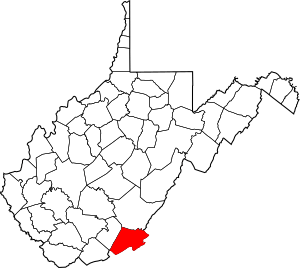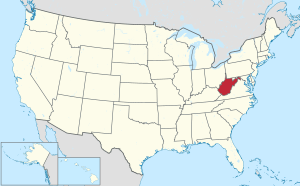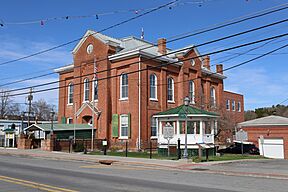Monroe County, West Virginia facts for kids
Quick facts for kids
Monroe County
|
||
|---|---|---|
|
Monroe County Courthouse in Union
Main Building at Sweet Springs Resort, designed by Thomas Jefferson.
Indian Creek Covered Bridge
Cook's Mill
|
||
|
||

Location of Monroe County in West Virginia
|
||

West Virginia's location within the U.S.
|
||
| Country | ||
| State | ||
| Founded | January 14, 1799 | |
| Named for | James Monroe | |
| Seat | Union | |
| Largest town | Peterstown | |
| Area | ||
| • Total | 1,230 km2 (474 sq mi) | |
| • Land | 1,230 km2 (473 sq mi) | |
| • Water | 2 km2 (0.9 sq mi) 0.2% | |
| Area rank | 20th | |
| Population | ||
| • Estimate
(2023)
|
12,382 |
|
| • Rank | 34th | |
| Time zone | UTC−5 (Eastern) | |
| • Summer (DST) | UTC−4 (EDT) | |
| Area code(s) | 304, 681 | |
| Congressional district | 1st | |
| Senate district | 10th | |
| House of Delegates district | 40th, 47th | |
| Website | https://www.monroecountywv.gov/ | |
Monroe County is a county in the U.S. state of West Virginia. As of the 2020 census, the population was 12,376. Its county seat is Union. Monroe County was the home of Andrew Summers Rowan of Spanish–American War fame, who is immortalized in Elbert Hubbard's classic A Message to Garcia. The county was also the site of the 1928 discovery of the 34.48 carat (6.896 g) Jones Diamond by Grover C. Jones and William "Punch" Jones. Monroe County celebrates its own holiday, Farmers' Day.
Contents
History
Monroe County was created from Greenbrier County on January 14, 1799, and was named for Virginia civic figure James Monroe, who would be elected fifth President of the United States in November 1816. It was one of fifty Virginia counties that were admitted to the Union as the state of West Virginia on June 20, 1863, at the height of the Civil War. Monroe County did not participate in the creation of the new state, but was included by Congressional decree. Almost all the men from Monroe who served in the Civil War enlisted in the Confederate army.
In 1863, West Virginia's counties were divided into civil townships, with the intention of encouraging local government. This proved impractical in the heavily rural state, and in 1872 the townships were converted into magisterial districts. Monroe County was initially divided into seven townships: Forest Hill, Red Sulphur, Second Creek, Springfield, Sweet Springs, Union, and Wolf Creek. In 1871, part of Forest Hill Township was added to the new county of Summers, and the remaining territory distributed between Red Sulphur and Springfield Townships. The following year, the six remaining townships became magisterial districts. Except for minor adjustments, the six historic magisterial districts were unchanged until the 1990s, when they were consolidated into three new districts: Central, Eastern, and Western.
Geography
Monroe County lies on the southeast side of West Virginia. Its southeast border abuts the northwest border of the state of Virginia. The New River flows northward for a short distance along the county's southwest border. The county's terrain is mountainous and tree-covered, with all sufficiently level surfaces devoted to agriculture. The terrain slopes to the north and west, with its highest part the middle part of its border with Virginia, at 3,862 ft (1,177 m) ASL. The county has a total area of 474 square miles (1,230 km2), of which 473 square miles (1,230 km2) is land and 0.9 square miles (2.3 km2) (0.2%) is water.
Major highways
Adjacent counties
- Greenbrier County (north)
- Alleghany County, Virginia (northeast)
- Craig County, Virginia (east)
- Giles County, Virginia (south)
- Summers County (west)
Watersheds
Tributaries of the James River, part of the Chesapeake Bay
Tributaries of the New River
- Greenbrier River
- Indian Creek
Tributaries of the Greenbrier River
- Second Creek
- Sinks Grove
National Natural Landmark
- Greenville Saltpeter Cave
National protected areas
- George Washington National Forest
- Jefferson National Forest In 2018 a natural gas pipeline project entered the Jefferson National Forest.
Demographics
| Historical population | |||
|---|---|---|---|
| Census | Pop. | %± | |
| 1800 | 4,188 | — | |
| 1810 | 5,444 | 30.0% | |
| 1820 | 6,620 | 21.6% | |
| 1830 | 7,798 | 17.8% | |
| 1840 | 8,422 | 8.0% | |
| 1850 | 10,204 | 21.2% | |
| 1860 | 10,757 | 5.4% | |
| 1870 | 11,124 | 3.4% | |
| 1880 | 11,501 | 3.4% | |
| 1890 | 12,429 | 8.1% | |
| 1900 | 13,130 | 5.6% | |
| 1910 | 13,055 | −0.6% | |
| 1920 | 13,141 | 0.7% | |
| 1930 | 11,949 | −9.1% | |
| 1940 | 13,577 | 13.6% | |
| 1950 | 13,123 | −3.3% | |
| 1960 | 11,584 | −11.7% | |
| 1970 | 11,272 | −2.7% | |
| 1980 | 12,873 | 14.2% | |
| 1990 | 12,406 | −3.6% | |
| 2000 | 14,583 | 17.5% | |
| 2010 | 13,502 | −7.4% | |
| 2020 | 12,376 | −8.3% | |
| 2023 (est.) | 12,382 | −8.3% | |
| US Decennial Census 1790–1960 1900–1990 1990–2000 2010–2020, 2023 |
|||
2010 census
As of the census of 2010, there were 13,502 people, 5,655 households, and 3,915 families in the county. The population density was 28.5 people per square mile (11.0 people/km2). There were 7,601 housing units at an average density of 16.1 units per square mile (6.2 units/km2). The racial makeup of the county was 97.5% white, 0.7% black or African American, 0.2% American Indian, 0.1% Asian, 0.2% from other races, and 1.3% from two or more races. Those of Hispanic or Latino origin made up 0.6% of the population. In terms of ancestry, 19.5% were Irish, 16.7% were English, 16.3% were German, 10.4% were American, and 5.7% were Scotch-Irish.
Of the 5,655 households, 27.4% had children under the age of 18 living with them, 55.7% were married couples living together, 9.3% had a female householder with no husband present, 30.8% were non-families, and 26.9% of all households were made up of individuals. The average household size was 2.38 and the average family size was 2.85. The median age was 45.0 years.
The median income for a household in the county was $39,574 and the median income for a family was $45,106. Males had a median income of $35,709 versus $23,782 for females. The per capita income for the county was $18,927. About 10.3% of families and 13.3% of the population were below the poverty line, including 18.1% of those under age 18 and 5.4% of those age 65 or over.
Natural landmarks
One of Monroe County's geological features is Haynes Cave, a former saltpeter mine. Workers in the mine found strange bones in the cave at the end of the 18th Century, and mailed them to Thomas Jefferson. Jefferson's study of the animal, the Megalonyx jeffersonii was arguably the birth of American paleontology. It is now the official West Virginia state fossil.
However, other saltpeter caves are in private ownership, and allow only limited public access due to ecological risks. One such is the Greenville Saltpeter Cave, designated a national natural landmark in 1973, and very important during the War of 1812.
Historic landmarks
- Indian Creek Covered Bridge
- Rehoboth Church
- Laurel Creek Covered Bridge
Education
Monroe County Schools operates public schools:
- James Monroe High School
- Mountain View Elementary/Middle School
- Peterstown Middle School
- Peterstown Elementary School
Farmers' Day
Farmers' Day is an annual event, held on the first Saturday in June in Union, to recognize the farming families in the surrounding area. The event, founded by Louie H. Peters, fills the weekend, with a Friday dance, a 3k run, a Saturday pancake breakfast, Sunday activities, and a parade held in the town of Union.
Notable inhabitants
- Henry Reed (1884-1968), old-time fiddler and banjo player
Communities
Towns
- Alderson (part)
- Peterstown
- Union (county seat)
Magisterial districts
- Central
- Eastern
- Western
Unincorporated communities
- Ballard
- Ballengee
- Bozoo
- Cashmere
- Cloverdale
- Crimson Springs
- Elmhurst
- Gap Mills
- Gates
- Glace
- Greenville
- Hillsdale
- Hollywood
- Keenan
- Knobs
- Laurel Branch
- Lillydale
- Lindside
- Monitor
- Pickaway
- Raines Corner
- Red Sulphur Springs
- Rock Camp
- Salt Sulphur Springs
- Sarton
- Secondcreek
- Sinks Grove
- Sweet Springs
- Waiteville
- Wayside
- Wikel
- Wolfcreek
- Zenith
See also
 In Spanish: Condado de Monroe (Virginia Occidental) para niños
In Spanish: Condado de Monroe (Virginia Occidental) para niños







